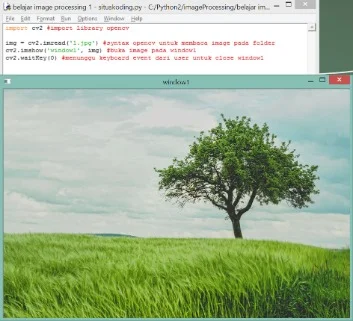Image Processing And Computer Vision Libraries For Python
Content
- Search Python Org
- Google Launches Two New Datasets For Building Superior Conversational Ai Models
- Pil
- Merging Images Using Pillow
- Creating A Watermark Using Pillow
Many other image processing, computer vision, and machine learning libraries utilize NumPy so it’s paramount to have it installed. While PIL and Pillow are great for simple image processing tasks, if you are serious about testing the computer vision waters, your time is better spent playing with SimpleCV. Once you’ve convinced yourself that computer vision is awesome, install OpenCV and re-learn what you did in SimpleCV. Over 95% of the code examples I will show you in this blog will be in OpenCV.

It is both a python and torch implementation and is an open source. OpenFace has algorithms for detecting a face from a pre-trained model in OpenCV or dlib. It Uses a deep neural network to represent the face on a 128-dimensional unit hypersphere and use the classification techniques to complete the regonization task.
Search Python Org
Written in C and Python, you can effortlessly learn essential functions within a few days. The pillow library, in its documentation, has included tutorials to assist learners in getting hold of the library. Written in Cython, the library is more Pythonic, thereby, easy to leverage and process images without clutters. For any machine learning enthusiast, learning scikit-Image is a must-know library. Pgmagick is a very good multipurpose image processing library for Python.
The resulting image, from applying arithmetic filter on the image with salt and pepper noise, is shown below. Upon comparison with the original grayscale image, we can see that it brightens the image too much and is unable to highlight the bright spots on the rose as well. Hence, it can be concluded that arithmetic filter fails to remove salt and pepper noise. Now that you have got a basic idea of what image processing is and what it is used for, let’s go ahead and learn about some of its specific applications. One thing you should definitely know in order to follow this tutorial is how exactly an image is represented in memory.
If you’re building a Python application that requires authentication, consider using Auth0 as it is bound to save you loads of time and effort. After signing up, setting up your application with Auth0 is fairly simple. If you need help, you can look through the documentation or post your question in the comment section below. To run the code, it’s better to create a virtual environment and install the needed packages there. This prevents package clutter and version conflicts in the system’s global Python interpreter. Instead of creating an application from scratch, I’ve put together a simple app that you can download to follow along.
Let’s say two classes of images stored in separate subfolders of “train” and flow_from_directory() read directly from the directory. The iterator returns one batch of augmented images in each iteration. This iterator can further be used to train the network using fit_generator(). A Python package implementing various CFA demosaicing algorithms and related utilities. Photini – A free, easy to use, digital photograph metadata editing application for Linux, Windows and MacOS. When creating various visualizations from images, Seaborn can be one of the most-used Python libraries nowadays.
Google Launches Two New Datasets For Building Superior Conversational Ai Models
The above code will display the actual and rotate image at 45 degree. Before dive deep into this topic, let’s understand image processing. As a coding exercise as well as for future use, we want to create thumbnail images from the images in working directory, and place them into a subfolder. I strongly believe that if you had the right teacher you could master computer vision and deep learning.
It is a simple gallery application that enables the user to upload images to a server and view the uploaded images. JAX is a library resulting from the union of Autograd and XLA for high-performance machine learning research. It provides NumPy, SciPy, automatic differentiation and first-class GPU/TPU support. The rose image that we have been using so far has a constant background i.e. black, therefore, we will be using a different image for this application to better show the algorithm’s capabilities. The reason is that if the background is constant, it makes the edge detection task rather simple, and we don’t want that. There are many different types of noise, like Gaussian noise, salt and pepper noise, etc.
The size of the thumbnail will not be same as the given size. PIL is a library that offers several standard procedures for manipulating images. It’s a powerful library but hasn’t been updated since 2009 and doesn’t support Python 3. Pillow builds on this, adding more features and support for Python 3. It supports a range of image file formats such as PNG, JPEG, PPM, GIF, TIFF, and BMP. We’ll see how to perform various operations on images such as cropping, resizing, adding text to images, rotating, greyscaling, etc., using this library.
Currently, it has more than 100 + functions for image processing like a watershed, convex points calculation, thresholding, convolution e.t.c. SimpleITK is written in C++, but it’s available for a large number of programming languages including Python. Python Imaging Library To perform basic operations on images like create thumnails, resize, rotation, convert between different file formats etc. The ImageDraw module is a very important component of the Pillow library. We can provide some simple 2D graphics support for image object. In the above code, we have imported the Image module from the PIL library. Before perform the merge operation, we need to make sure both images should be the same size.
Pil
Smart filtering is made possible by object recognition, location awareness, color analysis and other ML algorithms. Image processing is a mathematically intensive operation & one of the biggest areas of research for a big data field. Image processing analytics has applications from processing a X-Ray to identifying stationary objects in a self driving car. We have collected a list of Python libraries which can help you in image processing. But, for purposes of image processing, Numpy can help manipulate pixels, image cropping, and masking pixel values. Another Python library that you can use in image processing is Numpy. It contains data structures in the form of multi-dimensional and matrix arrays.

If NumPy’s main goal is large, efficient, multi-dimensional array representations, then, by far, the main goal of OpenCV is real-time image processing. This library has been around since 1999, but it wasn’t until the 2.0 release in 2009 did we see the incredible NumPy support. The library itself is written in C/C++, but Python bindings are provided when running the installer.
OpenCV must follow the presentation of images as a NumPy object. Also, high-speed computation through NumPy algorithms is valuable for creating fast image processing features when compared to pure Python. Digital image processing is the use of computer algorithms to process digital images and then apply significantly more complex algorithms to the image. It also refers to the implementation of methods that would otherwise be impossible with analog implementation. This article is helpful for all who has an interest to do something in image processing using python so, I thank you. I hope including the installation and some practical application areas of those libraries can shift the article from good to great. This article looks at 10 of the most commonly used Python libraries for image manipulation tasks.
This class can augment your images in batches on the fly which you can save in a hard disk or just let it be passed directly to your model. PythonMagick is the Python binding of the ImageMagick which is a free software. It supports cropping, changing colors, applying various effects, adding text and geometrical figures etc.
- Although the library is free and comes under the Apache 2 License, the course comes at a reasonable cost.
- For basic image manipulation, such as image cropping or simple filtering, a large number of simple operations can be realized with NumPy and SciPy only.
- SimpleITK is written in C++, but it’s available for a large number of programming languages including Python.
Each image is represented by a set of pixels i.e. a matrix of pixel values. For a grayscale image, the pixel values range from 0 to 255 and they represent the intensity of that pixel. For instance, if you have an image of 20 x 20 dimensions, it would be represented by a matrix of 20×20 (a total of 400-pixel values). Run it on your home server and it will let you find the right photo from your collection on any device.
But, among the different types of digital information consumed online and offline, many of it is made up of images and videos. Because of this, proper image processing is necessary to translate and obtain information for the business. ITK is an open-source, cross-platform system that has a wide suite of software tools to allow developers perform image analysis. NumPy is a fundamental package for scientific computing with Python.
Creating A Watermark Using Pillow
Due to the speed it offers, you can build several moderate-level workflows like feature extraction, face detection, image sharpening, denoising, geometrical transformations and more. But, SciPy cannot provide you with the flexibility to develop complex projects that require intensive workflows. Built on top of Python Image Library , Pillow is among the top three libraries for image processing. Especially used in batch processing, Pillow is commonly used within organizations. Another advantage of Pillow is that it supports a wide range of file format support, making it a one-stop-shop for all your image processing needs. Created in 2009, Pillow has gained over 1.5k forks, and 7.9k starts on GitHub.
